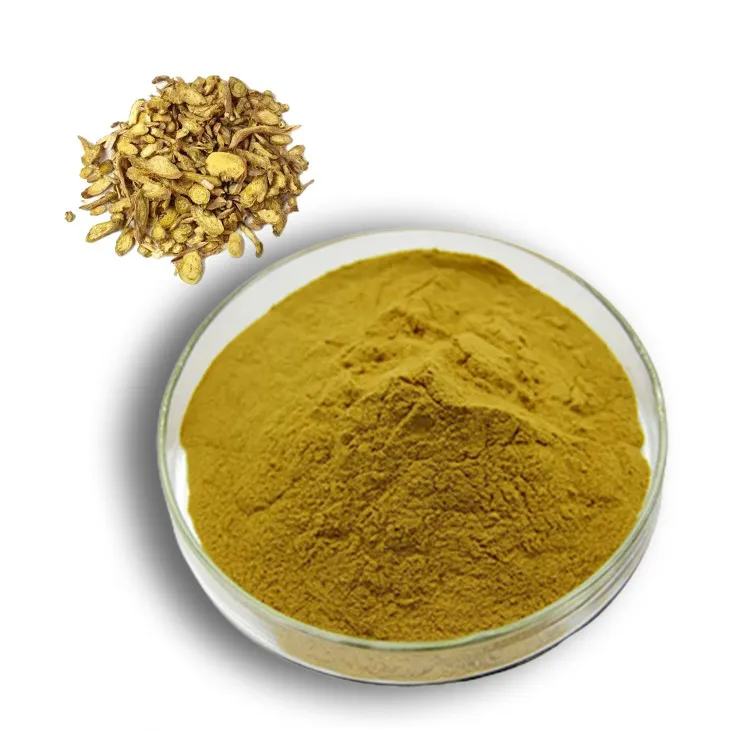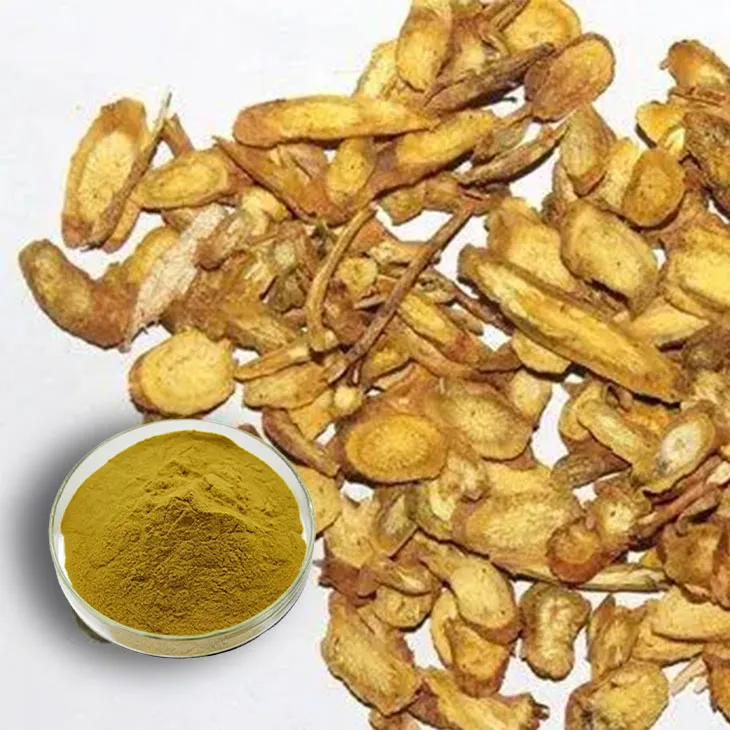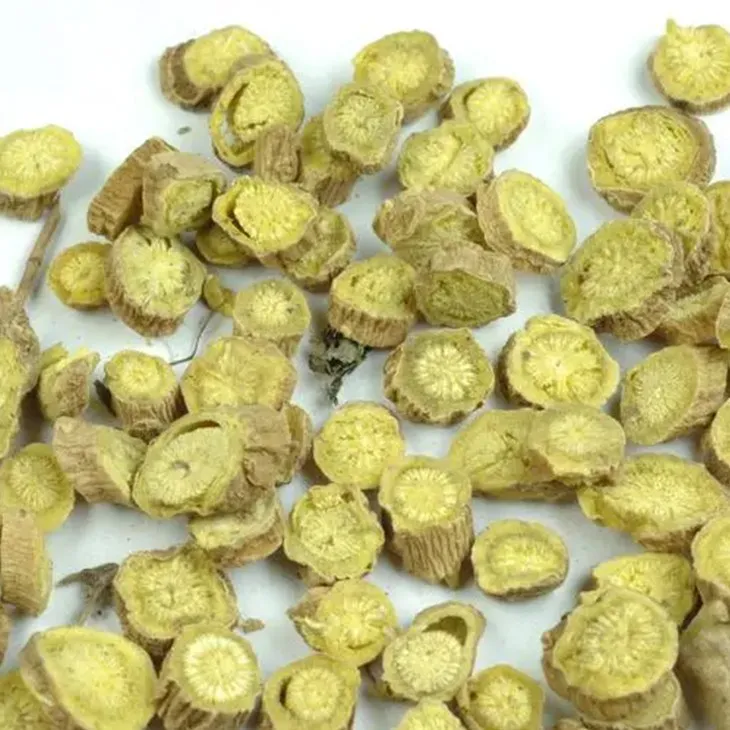- 0086-571-85302990
- sales@greenskybio.com
Baicalin: Nature's Best - Kept Secret.
2024-11-12

Introduction
Baicalin is a compound that has been gradually emerging from the shadows of nature's vast repository of bioactive substances. It is a flavonoid glycoside that is primarily sourced from Scutellaria baicalensis, a plant with a long history in traditional medicine. Despite its long - standing use in traditional systems, it remains relatively unknown to the general public compared to some more popular herbal remedies. However, in recent years, scientific research has been steadily unearthing its remarkable properties, making it a subject of great interest in both the scientific and natural health communities.

The Chemical Structure and Properties of Baicalin
Baicalin has a complex chemical structure that is central to its diverse biological activities. Its molecular formula is \(C_{21}H_{18}O_{11}\). It consists of a flavone moiety, baicalein, which is glycosylated with a glucuronic acid residue. This unique chemical makeup endows baicalin with certain physicochemical properties that influence its solubility, stability, and ability to interact with biological targets.
The flavonoid part of baicalin gives it antioxidant properties. Flavonoids are known for their ability to scavenge free radicals, which are highly reactive molecules that can cause damage to cells and tissues. By neutralizing these free radicals, baicalin may help protect cells from oxidative stress, which is implicated in a variety of diseases including cancer, cardiovascular diseases, and neurodegenerative disorders.

Neuroprotective Potential of Baicalin
Mechanisms of Neuroprotection
One of the most promising aspects of baicalin is its potential as a neuroprotective agent. There are several mechanisms through which baicalin may exert its neuroprotective effects.
Firstly, it has been shown to have anti - inflammatory properties in the context of the nervous system. Neuroinflammation is a common feature in neurodegenerative diseases such as Alzheimer's and Parkinson's. Baicalin can inhibit the activation of microglia, which are the immune cells in the brain. When microglia are over - activated, they can release pro - inflammatory cytokines that can damage neurons. By suppressing microglial activation, baicalin may reduce neuroinflammation and thus protect neurons.
Secondly, baicalin may also act as an antioxidant within the nervous system. As mentioned earlier, oxidative stress is a major contributor to neuronal damage. Baicalin's ability to scavenge free radicals can help maintain the redox balance in neurons, preventing the oxidative damage to cellular components such as lipids, proteins, and DNA.
Finally, baicalin may have a role in promoting neuronal survival and regeneration. It has been shown to regulate certain signaling pathways that are involved in cell survival, such as the PI3K/Akt pathway. Activation of this pathway can enhance neuronal survival and may also stimulate axonal regeneration in damaged neurons.
Implications for Neurodegenerative Diseases
The neuroprotective effects of baicalin have significant implications for neurodegenerative diseases. Alzheimer's disease, for example, is characterized by the accumulation of amyloid - beta plaques and tau tangles in the brain, which lead to neuronal death and cognitive decline. Baicalin may be able to interfere with the formation of amyloid - beta plaques or promote their clearance. In addition, by reducing neuroinflammation and oxidative stress, it could potentially slow down the progression of the disease.
Similarly, in Parkinson's disease, which is associated with the loss of dopaminergic neurons in the substantia nigra, baicalin may help protect these neurons from damage. It could also potentially modulate the immune response in the brain, which is often dysregulated in Parkinson's disease.

Effects on the Cardiovascular System
Blood Pressure Regulation
Baicalin has also been shown to have an impact on the cardiovascular system. One of the key areas of interest is blood pressure regulation. Several mechanisms may be involved in baicalin - mediated blood pressure control.
Baicalin can act on the vascular endothelium, which plays a crucial role in maintaining vascular homeostasis. It can enhance the production of nitric oxide (NO) in endothelial cells. NO is a vasodilator, meaning it relaxes the smooth muscle in blood vessels, leading to an increase in vessel diameter and a decrease in blood pressure.
In addition, baicalin may also affect the renin - angiotensin - aldosterone system (RAAS), which is an important regulator of blood pressure. By inhibiting certain components of the RAAS, such as angiotensin - converting enzyme (ACE), baicalin can prevent the formation of angiotensin II, a potent vasoconstrictor. This, in turn, can help lower blood pressure.
Lipid Metabolism
Another aspect of baicalin's effect on the cardiovascular system is its influence on lipid metabolism. Dyslipidemia, characterized by abnormal levels of lipids such as cholesterol and triglycerides in the blood, is a major risk factor for cardiovascular diseases.
Baicalin has been shown to lower blood lipid levels. It can inhibit the absorption of dietary cholesterol in the intestine, reducing the amount of cholesterol that enters the bloodstream. It may also enhance the metabolism of lipids in the liver, promoting the breakdown and excretion of cholesterol and triglycerides.

Biosynthesis of Baicalin in Plants
The biosynthesis of baicalin within the plant is a complex process that involves multiple enzymatic steps. Understanding this process is not only of scientific interest but also has practical implications for the production of baicalin.
The biosynthesis of baicalin starts from the shikimate pathway, which is a major route for the biosynthesis of aromatic compounds in plants. Phenylalanine, an amino acid produced from the shikimate pathway, is converted into cinnamic acid through the action of phenylalanine ammonia - lyase (PAL). Cinnamic acid is then further metabolized through a series of enzymatic reactions to form baicalein, the aglycone form of baicalin.
Finally, baicalein is glycosylated by a UDP - glucuronosyltransferase to form baicalin. The regulation of these enzymatic steps is crucial for the production of baicalin in plants. Environmental factors such as light, temperature, and nutrient availability can affect the expression of the genes encoding these enzymes, thereby influencing the biosynthesis of baicalin.
Conclusion
Baicalin is a natural substance with a wealth of potential health benefits. Its neuroprotective properties and effects on the cardiovascular system make it a valuable compound for further research and development. Despite its relatively low - profile status compared to some other natural products, it holds great promise in the fields of neurodegenerative disease treatment and cardiovascular health promotion.
The study of its biosynthesis in plants also opens up new avenues for more efficient production methods, which could potentially make it more accessible for both research and therapeutic applications. As research on baicalin continues to unfold, it is likely that more of its secrets will be revealed, and it may one day become a more mainstream and widely recognized natural remedy.
FAQ:
What is baicalin?
Baicalin is an interesting compound found in Scutellaria baicalensis. It has a complex chemical nature and shows various biological activities.
Why is baicalin considered to have neuroprotective potential?
Baicalin may play a role in protecting neurons from damage. This property could be significant for neurodegenerative diseases like Alzheimer's and Parkinson's, but the exact mechanisms are still being studied.
How does baicalin affect the cardiovascular system?
Studies have demonstrated that baicalin can influence blood pressure regulation and lipid metabolism. This makes it potentially useful in the prevention and treatment of cardiovascular disorders.
What makes the biosynthesis of baicalin within the plant fascinating?
Understanding the biosynthesis of baicalin within the plant could lead to more efficient production methods. It is a complex process that holds the key to better utilization of this valuable compound.
Why has baicalin remained relatively unknown?
Despite its valuable properties, baicalin has remained relatively unknown perhaps because it is a natural substance and more research is needed to fully understand and promote it.
Related literature
- The Neuroprotective Effects of Baicalin: A Review"
- "Baicalin and Cardiovascular Health: Current Research"
- "Biosynthesis of Baicalin: Insights and Future Directions"
- ▶ Hesperidin
- ▶ citrus bioflavonoids
- ▶ plant extract
- ▶ lycopene
- ▶ Diosmin
- ▶ Grape seed extract
- ▶ Sea buckthorn Juice Powder
- ▶ Beetroot powder
- ▶ Hops Extract
- ▶ Artichoke Extract
- ▶ Reishi mushroom extract
- ▶ Astaxanthin
- ▶ Green Tea Extract
- ▶ Curcumin Extract
- ▶ Horse Chestnut Extract
- ▶ Other Problems
- ▶ Boswellia Serrata Extract
- ▶ Resveratrol Extract
- ▶ Marigold Extract
- ▶ Grape Leaf Extract
- ▶ blog3
-
Cranberry Plants and Skin - care Products.
2024-11-12
-
Licorice Root Extract Powder
2024-11-12
-
Red Vine Extract
2024-11-12
-
Lemon Extract
2024-11-12
-
Tongkat Ali Extract
2024-11-12
-
Black Pepper Extract
2024-11-12
-
Gynostemma pentaphyllum extract
2024-11-12
-
Stevia Extract
2024-11-12
-
Diosmin
2024-11-12
-
Phyllanthus Emblica Extract
2024-11-12
-
Wheat Germ Extract
2024-11-12





















